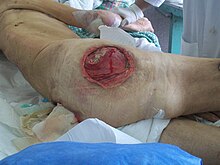
Back قرحة فراش Arabic Dekubitus BS Úlcera per pressió Catalan برینی سەرجێ CKB Proleženina Czech Liggesår Danish Dekubitus German ތަންފާރު DV Pièga da decùbit EML Escara (medicina) Spanish
| Pressure ulcer | |
|---|---|
| Other names | Decubitus (plural: decubitūs), or decubitous ulcers, pressure injuries, pressure sores, bedsores |
 | |
| Stage IV decubitus displaying the tuberosity of the ischium protruding through the tissue, and possible onset of osteomyelitis. | |
| Specialty | Plastic surgery |
| Complications | infection |

Pressure ulcers, also known as pressure sores, bed sores or pressure injuries, are localised damage to the skin and/or underlying tissue that usually occur over a bony prominence as a result of usually long-term pressure, or pressure in combination with shear or friction. The most common sites are the skin overlying the sacrum, coccyx, heels, and hips, though other sites can be affected, such as the elbows, knees, ankles, back of shoulders, or the back of the cranium.
Pressure ulcers occur due to pressure applied to soft tissue resulting in completely or partially obstructed blood flow to the soft tissue. Shear is also a cause, as it can pull on blood vessels that feed the skin. Pressure ulcers most commonly develop in individuals who are not moving about, such as those who are on chronic bedrest or consistently use a wheelchair. It is widely believed that other factors can influence the tolerance of skin for pressure and shear, thereby increasing the risk of pressure ulcer development. These factors are protein-calorie malnutrition, microclimate (skin wetness caused by sweating or incontinence), diseases that reduce blood flow to the skin, such as arteriosclerosis, or diseases that reduce the sensation in the skin, such as paralysis or neuropathy. The healing of pressure ulcers may be slowed by the age of the person, medical conditions (such as arteriosclerosis, diabetes or infection), smoking or medications such as anti-inflammatory drugs.
Although often prevented and treatable if detected early, pressure ulcers can be very difficult to prevent in critically ill people, frail elders, and individuals with impaired mobility such as wheelchair users (especially where spinal injury is involved). Primary prevention is to redistribute pressure by regularly turning the person. The benefit of turning to avoid further sores is well documented since at least the 19th century.[1] In addition to turning and re-positioning the person in the bed or wheelchair, eating a balanced diet with adequate protein[2] and keeping the skin free from exposure to urine and stool is important.[3]
The rate of pressure ulcers in hospital settings is high; the prevalence in European hospitals ranges from 8.3% to 23%, and the prevalence was 26% in Canadian healthcare settings from 1990 to 2003.[4] In 2013, there were 29,000 documented deaths from pressure ulcers globally, up from 14,000 deaths in 1990.[5]
The United States has tracked rates of pressure injury since the early 2000s. Whittington and Briones reported nationwide rates of pressure injuries in hospitals of 6% to 8%.[6] By the early 2010s, Lyder and colleagues had research the rate of pressure injury to drop to about 4.5% across the Medicare population, following the introduction of the International Guideline for pressure injury prevention.[7] Padula and colleagues have witnessed a +29% uptick in pressure injury rates in recent years associated with the rollout of penalizing Medicare policies.[8]
- ^ Black JM, Edsberg LE, Baharestani MM, Langemo D, Goldberg M, McNichol L, Cuddigan J (February 2011). "Pressure ulcers: avoidable or unavoidable? Results of the National Pressure Ulcer Advisory Panel Consensus Conference". Ostomy/Wound Management. 57 (2): 24–37. PMID 21350270.
- ^ Saghaleini SH, Dehghan K, Shadvar K, Sanaie S, Mahmoodpoor A, Ostadi Z (April 2018). "Pressure Ulcer and Nutrition". Indian Journal of Critical Care Medicine. 22 (4): 283–289. doi:10.4103/ijccm.IJCCM_277_17. PMC 5930532. PMID 29743767.
- ^ Boyko TV, Longaker MT, Yang GP (February 2018). "Review of the Current Management of Pressure Ulcers". Advances in Wound Care. 7 (2): 57–67. doi:10.1089/wound.2016.0697. PMC 5792240. PMID 29392094.
- ^ McInnes E, Jammali-Blasi A, Bell-Syer SE, Dumville JC, Middleton V, Cullum N (September 2015). "Support surfaces for pressure ulcer prevention". The Cochrane Database of Systematic Reviews. 2015 (9): CD001735. doi:10.1002/14651858.CD001735.pub5. PMC 7075275. PMID 26333288.
- ^ Mensah GA, Roth GA, Sampson UK, Moran AE, Feigin VL, Forouzanfar MH, et al. (GBD 2013 Mortality Causes of Death Collaborators) (January 2015). "Global, regional, and national age-sex specific all-cause and cause-specific mortality for 240 causes of death, 1990-2013: a systematic analysis for the Global Burden of Disease Study 2013". Lancet. 385 (9963): 117–171. doi:10.1016/S0140-6736(14)61682-2. PMC 4340604. PMID 25530442.
- ^ Whittington KT, Briones R (Nov 2004). "National Prevalence and Incidence Study: 6-year sequential acute care data". Advances in Skin & Wound Care. 17 (9): 490–494. doi:10.1097/00129334-200411000-00016. PMID 15632743. S2CID 22039909.
- ^ Lyder CH, Wang Y, Metersky M, Curry M, Kliman R, Verzier NR, Hunt DR (September 2012). "Hospital-acquired pressure ulcers: results from the national Medicare Patient Safety Monitoring System study". Journal of the American Geriatrics Society. 60 (9): 1603–1608. doi:10.1111/j.1532-5415.2012.04106.x. PMID 22985136. S2CID 26120917.
- ^ Padula WV, Black JM, Davidson PM, Kang SY, Pronovost PJ (June 2020). "Adverse Effects of the Medicare PSI-90 Hospital Penalty System on Revenue-Neutral Hospital-Acquired Conditions". Journal of Patient Safety. 16 (2): e97–e102. doi:10.1097/PTS.0000000000000517. hdl:10453/142988. PMID 30110019. S2CID 52001575.
© MMXXIII Rich X Search. We shall prevail. All rights reserved. Rich X Search